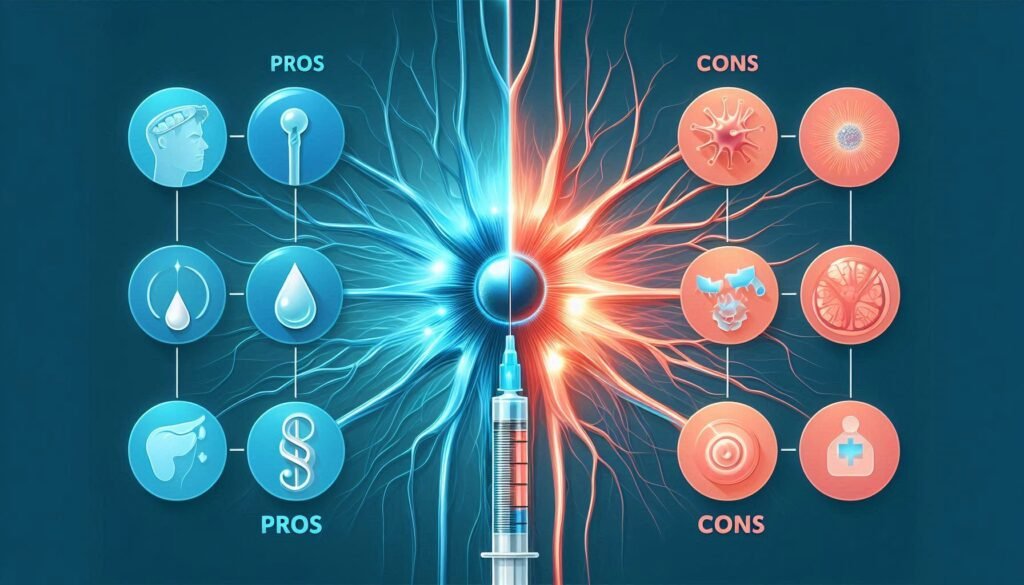Paresthesia can be an unsettling experience, often characterized by tingling, numbness, or a prickling sensation in various parts of the body. While many may brush it off as something minor, understanding its underlying causes is crucial for effective treatment. From nerve compression to systemic conditions like diabetes and multiple sclerosis, paresthesia can arise from numerous sources.
Navigating through the array of treatment options available might feel overwhelming. Whether you’re seeking relief through medications or exploring natural remedies and advanced therapies, there’s hope on the horizon. This comprehensive overview of paresthesia treatment options will guide you through each possibility while empowering you to take control of your health journey. Let’s delve deeper into this multifaceted condition and uncover ways to manage your symptoms effectively!

Understanding Paresthesia: Causes, Symptoms, and Diagnosis
Paresthesia refers to abnormal sensations in the skin, commonly described as tingling, prickling, or numbness. These sensations can occur anywhere on the body but are most frequently felt in the hands and feet. While paresthesia is often temporary and harmless, it can sometimes indicate underlying medical issues.
The causes of paresthesia are diverse. Common triggers include nerve compression from repetitive movements, vitamin deficiencies (like B12), diabetes-related neuropathy, or conditions like multiple sclerosis. Stress and anxiety may also lead to these uncomfortable sensations.
Symptoms typically manifest suddenly or gradually over time. Individuals might experience a “pins-and-needles” feeling after sitting too long or following an injury. Persistent symptoms warrant professional evaluation since they could signal more serious health problems.
Diagnosis involves a thorough medical history and physical examination by healthcare providers. Additional tests—such as blood work, imaging studies, or nerve conduction studies—may be necessary to pinpoint the exact cause of paresthesia for appropriate treatment planning.
Pharmacological Interventions: First-Line Treatments for Paresthesia
Pharmacological interventions play a crucial role in managing paresthesia. These treatments target the underlying causes of nerve dysfunction and help alleviate symptoms. Common first-line medications include anticonvulsants such as gabapentin and pregabalin, which are effective for neuropathic pain.
Antidepressants also show promise in treating paresthesia-related discomfort. Certain tricyclic antidepressants, like amitriptyline, can provide relief by modulating pain signals in the nervous system. Doctors often prescribe these alongside anticonvulsants for a synergistic effect.
Topical treatments can be beneficial too. Capsaicin cream or lidocaine patches may help reduce localized symptoms without systemic side effects. These options allow patients to manage their condition more comfortably at home.
It’s important to note that medication efficacy varies among individuals. Regular follow-ups with healthcare providers ensure tailored treatment plans based on personal responses and any potential side effects experienced during therapy.
Non-Pharmacological Approaches: Physical and Occupational Therapy
Physical and occupational therapy play crucial roles in managing paresthesia. These non-pharmacological approaches aim to improve function and reduce discomfort caused by nerve-related issues. A physical therapist often evaluates the body’s mechanics, focusing on exercises that enhance strength, flexibility, and coordination.
Occupational therapy complements this by helping individuals perform daily tasks more effectively. Therapists customize strategies that adapt activities to minimize symptoms while promoting independence. This is particularly beneficial for those whose everyday lives are impacted by symptoms.
Both therapies employ modalities such as electrical stimulation or ultrasound to stimulate nerves and alleviate sensations of tingling or numbness. Additionally, techniques like desensitization can help re-train the nervous system to respond differently to stimuli.
Regular sessions can lead to significant improvements over time. Patients often experience enhanced mobility and quality of life through tailored exercise regimens and adaptive equipment recommendations from their therapists.
Natural Remedies and Lifestyle Modifications for Symptom Management
Natural remedies and lifestyle modifications can play a significant role in managing paresthesia symptoms. Incorporating regular physical activity is vital, as exercise promotes blood circulation and enhances nerve function. Gentle activities like walking, yoga, or swimming can be particularly beneficial.
Mindfulness practices such as meditation and deep breathing exercises also help reduce stress, which may exacerbate paresthesia symptoms. These techniques foster relaxation and provide mental clarity. Engaging in these practices daily can create a positive impact on overall well-being.
Dietary changes are another essential component of symptom management. Consuming foods rich in vitamins B12, B6, and folate supports nerve health. Including omega-3 fatty acids found in fish or flaxseed might also alleviate inflammation associated with nerve issues.
Staying hydrated is crucial for maintaining optimal bodily functions. Dehydration can worsen numbness or tingling sensations; therefore, drinking enough water throughout the day should not be overlooked. Small adjustments to daily routines often lead to meaningful improvements over time.
Alternative Therapies: Acupuncture, Massage, and Mind-Body Techniques
Alternative therapies can offer significant relief for those experiencing paresthesia. Acupuncture, a practice rooted in traditional Chinese medicine, involves inserting fine needles into specific points on the body. This technique aims to restore balance and enhance nerve function, potentially alleviating numbness and tingling sensations.
Massage therapy is another beneficial option. By applying pressure to muscles and soft tissues, massage can improve blood circulation and reduce tension around nerves. Regular sessions may help alleviate symptoms associated with chronic conditions that cause paresthesia.
Mind-body techniques such as yoga and meditation promote relaxation while fostering awareness of bodily sensations. These practices encourage deep breathing, which can reduce stress levels—an important factor that often exacerbates paresthesia symptoms.
Incorporating these alternative therapies may complement more conventional treatment methods. Many individuals find that a holistic approach provides them with an improved quality of life while addressing their unique experiences with paresthesia.
Nutritional Strategies to Support Nerve Health and Reduce Symptoms
Nutritional strategies play a crucial role in supporting nerve health and managing symptoms of paresthesia. Incorporating foods rich in vitamins B1, B6, and B12 can enhance nerve function. These vitamins are essential for maintaining myelin sheaths that protect nerves. You can find them in whole grains, legumes, nuts, and fortified cereals.
Omega-3 fatty acids also contribute significantly to nerve health. They possess anti-inflammatory properties that may reduce discomfort associated with numbness or tingling sensations. Fatty fish like salmon, walnuts, and flaxseeds are excellent sources of these beneficial fats.
Antioxidant-rich foods help combat oxidative stress on nerves as well. Fruits such as berries and vegetables like spinach provide necessary nutrients to promote overall neurological function while potentially easing symptoms.
Staying hydrated is vital for optimal nerve performance. Water supports every cell in the body while ensuring efficient nutrient transport. Aim for adequate fluid intake throughout the day to maintain proper hydration levels.
Surgical Options for Severe or Persistent Paresthesia
Surgical options for severe or persistent paresthesia are usually considered when conservative treatments fail to provide relief. Surgical interventions aim to address the underlying causes of nerve compression or damage. Conditions such as carpal tunnel syndrome, herniated discs, and peripheral nerve entrapment may necessitate surgical solutions.
One common procedure is decompression surgery. This technique relieves pressure on affected nerves by removing surrounding structures that constrain them. It can significantly reduce symptoms in patients suffering from conditions like carpal tunnel syndrome.
Another option is neurolysis, which involves cutting scar tissue around a nerve to restore its function. This method is typically used for patients experiencing chronic pain due to nerve injury or irritation.
If there’s significant nerve damage, grafting may be required. In this procedure, healthy segments of nerves are transplanted to replace damaged areas. Each surgical approach has specific indications and potential risks that should be thoroughly discussed with a healthcare professional before proceeding.
Emerging Technologies and Cutting-Edge Treatments
Emerging technologies are revolutionizing the treatment landscape for paresthesia. Neuromodulation techniques, such as transcranial magnetic stimulation (TMS), show promise in alleviating nerve-related symptoms. TMS uses magnetic fields to stimulate nerve cells in the brain, potentially reducing sensations of tingling or numbness.
Another exciting area is bioelectronic medicine. This innovative approach employs devices that interact directly with the nervous system to modulate pain and sensory experiences. These implants can offer real-time adjustments based on individual responses, paving the way for tailored treatments.
Wearable technology is also gaining traction. Devices equipped with sensors can monitor symptom patterns and provide feedback to patients and healthcare providers alike. This data-driven approach enhances personalized care strategies.
Advancements in regenerative medicine hold potential for repairing damaged nerves through stem cell therapies or tissue engineering. While still largely experimental, these developments could significantly alter how we understand and treat paresthesia in years to come.
Tailoring Treatment Plans: Addressing Underlying Conditions
Tailoring treatment plans for paresthesia involves addressing underlying conditions that may contribute to symptoms. Common causes include diabetes, multiple sclerosis, and vitamin deficiencies. Identifying these root issues is crucial in developing a comprehensive management strategy.
For diabetic patients, controlling blood sugar levels can significantly alleviate nerve-related symptoms. Regular monitoring and insulin or medication adjustments are essential components of their care plan. Meanwhile, those with autoimmune disorders may benefit from immunosuppressive therapies aimed at reducing inflammation affecting the nerves.
Vitamin B12 deficiency is another common culprit behind paresthesia. Supplementation can lead to remarkable improvements in sensation and function. Healthcare providers often recommend dietary changes alongside supplements to ensure optimal nutrient intake.
Understanding individual patient history allows healthcare professionals to customize interventions effectively. This personalized approach not only addresses immediate symptoms but also promotes long-term health by managing the underlying medical conditions contributing to paresthesia.
Long-Term Management: Combining Therapies for Optimal Results
Long-term management of paresthesia often requires a multifaceted approach that combines various therapies for optimal results. The key is to tailor treatment plans to the individual, addressing both symptoms and underlying causes.
Patients can benefit from integrating pharmacological treatments with physical or occupational therapy. This combination helps in improving mobility and function while managing pain. For many, lifestyle modifications play an essential role as well; maintaining a balanced diet rich in vitamins B12, D, and antioxidants supports nerve health.
Natural remedies like acupuncture or regular massages can complement conventional methods by promoting relaxation and reducing stress levels. Additionally, engaging in mind-body techniques such as meditation can enhance overall wellbeing.
Regular follow-ups with healthcare providers are crucial for monitoring progress. Adjustments may be needed based on how symptoms evolve over time. By embracing a comprehensive overview of paresthesia treatment options, individuals can find relief more effectively while enhancing their quality of life through sustained management strategies tailored specifically for them.


